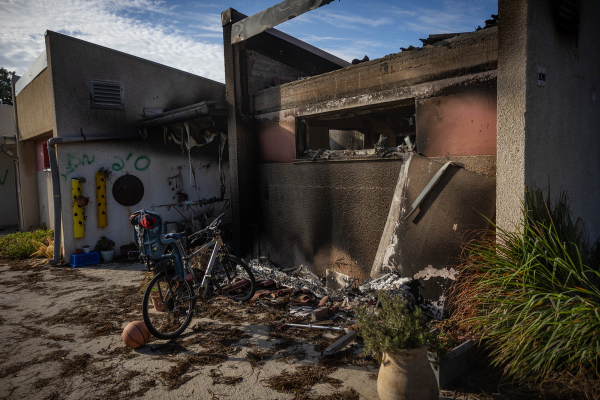This small desert kibbutz of Nir Oz, within sight of the Gaza border, was among the hardest hit during Hamas’s Oct. 7 assault. One in every four residents was either killed or kidnapped.
By Etgar Lefkovits, JNS
In blackened, charred homes, a team of Israeli archaeologists sift through the rubble and ashes, looking for the smallest sign of human remains.
It could be a sliver of bone, teeth, or a personal adornment like a watch, ring or piece of jewelry.
By signing up, you agree to receive emails from JNS and our advertising partners
“We are used to excavating through the destructions of layers of our history from hundreds and thousands of years ago,” said Joe Uziel of the Israel Antiquities Authority, who normally heads the IAA’s Dead Sea Scrolls Division, during a tour at the site for the international press on Thursday.
The team of about 15 archaeologists, assisted by Israeli soldiers, have so far found the remains of dozens of individuals—including 10 who were listed as missing, he said.
The archaeologists were called in because even after search and rescue teams scoured the area, scores of people remained unaccounted for, some of them burnt to ash.
After the remains are found, they undergo DNA testing. The emotion-laden yet meticulous and delicate work has not been easy for the archaeologists, who, in their routine, are detached from the layers of ancient history they sift through.
“It’s a mixed feeling. … Do you want to find something or do you not want to find something? Because if you find something that means you’ve determined that someone is gone and at the same time, not finding someone means that they [the families] remain in this limbo of not knowing,” said Uziel. “At least we can provide some comfort to families and loved ones who have lost so much.”
Archaeologist Oren Shmueli added, “Never in my darkest dream did I think I would be in such a situation.” He noted the hardest thing one can find are the personal items—like rings or watches—because then you get a feel for who the person was.
Amid the carnage, a miniature book of Psalms, blackened by fire, is delicately removed from the debris.
Blood stains the walls and floors of these homes.
Inside one of the safe rooms of the gutted home, a girl’s doll lay on the bed.
One in four killed or kidnapped
This small desert kibbutz, within sight of the Gaza border, was among the hardest hit during Hamas’s Oct. 7 assault. One in every four residents was either killed or kidnapped.
“On Oct. 7 our life stopped,” said Natalie Madmon, whose 77-year-old mother, Ofelia Roitman, an Argentinian-born educator, was kidnapped in the attack. Roitman had just made herself a cup of coffee and settled in the sealed room of her house with the lights off when the terrorists barged in, her daughter recounted. Her last phone message, at 9:37 that fateful morning, was: “They are here, please please.”
The kibbutz, which was once home to 400 people, now lies lifeless, like the other border communities a closed military zone, and now also a dig site. Seventy-three of its members were kidnapped, while 29 were murdered, along with 11 Thai workers.
“To see this place which was once so happy all blackened, to smell the burning, is horrifying,” said Madmon, her hands black with soot. A kibbutz member whose parents were murdered in the attack, Amit Siman-Tov, enters the communal dining hall, the kitchen of which was set ablaze. The two women embrace in tears.
Natalie Madmon, whose mother is a captive in Gaza, is hugged at Kibbutz Nir Oz by Amit Simantov, whose parents were killed by Hamas, Oct. 9, 2023. Photo by Rina Castelnuovo.
Death and destruction
The foreign workers compound just down the road remains a tableau of death and destruction and a scene of utter carnage. Overturned belongings strewn everywhere. Shelves of pots and pans in the kitchen overturned and on the ground. Sandals. A broom. A broken bicycle. Clothes. The bullet-riddled bomb shelter, where, like their Jewish employers, the workers were similarly massacred, bloodied, blood stains on the walls and ceilings.
The killers on that morning did not differentiate by sex, religion or nationality.
The adjacent agricultural fields lay desolate.
Outside the kibbutz dining hall, just down the path from the archaeological sifting operation underway, the sprinklers were on, watering the grass.
Israel at War with Hamas. Support Israel Today!
The people of Israel need your help at this most critical time. Please make a donation to help protect and defend Israelis against unprecedented Hamas terror.
Rockets are falling. Sirens blare, with seconds to run for cover. IDF soldiers risk their lives battling terrorists inside Gaza. Thousands forced to abandon their homes in southern Israel.
To fight terror and save lives, UWI provides bomb shelters, anti-terror vehicles, protective gear, security equipment, medical assistance, relief to victims and much more. Help Israel fight and win this war against Hamas. The time to act is now!
